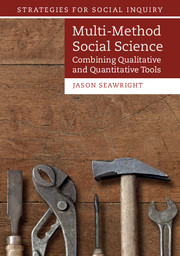Book contents
- Frontmatter
- Contents
- List of Figures and Tables
- Acknowledgments
- 1 Integrative Multi-Method Research
- 2 Causation as a Shared Standard
- 3 Using Case Studies to Test and Refine Regressions
- 4 Case Selection after Regression
- 5 Combining Case Studies and Matching
- 6 Combining Case Studies and Natural Experiments
- 7 Embedding Case Studies within Experiments
- 8 Multi-Method Case Studies
- Appendix: Qualitative Causal Models and the Potential-Outcomes Framework
- References
- Index
8 - Multi-Method Case Studies
Published online by Cambridge University Press: 05 September 2016
- Frontmatter
- Contents
- List of Figures and Tables
- Acknowledgments
- 1 Integrative Multi-Method Research
- 2 Causation as a Shared Standard
- 3 Using Case Studies to Test and Refine Regressions
- 4 Case Selection after Regression
- 5 Combining Case Studies and Matching
- 6 Combining Case Studies and Natural Experiments
- 7 Embedding Case Studies within Experiments
- 8 Multi-Method Case Studies
- Appendix: Qualitative Causal Models and the Potential-Outcomes Framework
- References
- Index
Summary
For much of this book, the focus has been on designs in which quantitative methods of one sort or another are used to make the main causal inference of interest, with qualitative components added to test assumptions and make new discoveries. These designs should not be seen as privileging one method over the other. Assumptions about confounding, measurement, the existence of causal pathways, random or as-if random assignment, SUTVA, experimental realism, and so forth are the heart of quantitative causal inference. When the qualitative component of a multi-method design is the element responsible for connecting evidence to these assumptions, that component is contributing directly to clarifying the core issues of causal inference.
However, while it is spurious to read these designs as privileging quantitative over qualitative methods, there is nothing special or logically privileged about the framework in which quantitative methods make the final causal inference and qualitative methods speak to assumptions. This chapter turns the tables to consider integrative multi-method research designs in which qualitative research structures the overall study and produces the final causal inference, and in which quantitative research design components are used to test and refine critical assumptions. The relative length of the discussion of these two frameworks in this book reflects the relatively greater degree to which the assumptions necessary for causal inference using quantitative and experimental methods have been analyzed and formalized, not the relative value of the two paradigms.
In exploring ways that quantitative methods can contribute to primarily qualitative causal inferences, this chapter considers several options. First, it discusses the option of using a quantitative analysis to test the generalizability of findings from one or more case studies – a framework widely regarded as the major way in which to construct multi-method research, but one for which deep difficulties emerge. More viable options are then analyzed. The chapter discusses how quantitative analysis can sometimes add information by estimating the size of causal effects that are pivotal to case-study arguments. Alternatively, scholars can sometimes benefit from using quantitative (ideally experimental) methods as a step in a process-tracing design. Another useful integrative design involves taking an initial set of similarities and differences among quantitative causal effect findings for different research contexts as the outcome to be explained in a comparative-case-study analysis.
- Type
- Chapter
- Information
- Multi-Method Social ScienceCombining Qualitative and Quantitative Tools, pp. 171 - 191Publisher: Cambridge University PressPrint publication year: 2016



